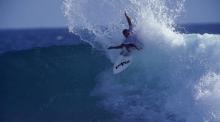
EEL / WATER / ROCK / MAN: Q&A with Jason Houston
This year we're welcoming Orion picture editor, Jason Houston, with an Orion short film as well as a photo exhibit of one of his personal projects. The film, eel · water · rock · man, a short documentary produced at Orion with former executive editor, Hal Clifford, takes a look atthe last man on the East Coast who still fishes for eels with an ancient stone weir. The documentary is personal, taking us into the thoughts and everyday life of Ray Turner. What results is a reflective and introspective piece that although focused on a specific subject, encourages us to think more about our own general philosophy on life.
We caught up with Houston to learn more about the inspiration behind the film and what draws him to producing short documentaries.
eel•water•rock•man from Orion Magazine on Vimeo.
 What led you to Ray Turner?
What led you to Ray Turner?
We met Ray Turner through writer and artist, James Prosek. Hal Clifford (co-creator of the film) worked with James on several pieces for Orion magazine (where Jason is picture editor and Hal was executive editor), including an excerpt from James's book Eels: An Exploration, from New Zealand to the Sargasso, of the World's Most Mysterious Fish (HarperCollins, 2010). Ray was one of James’s subjects in the book and his life out there on the Delaware River fascinated us. He was relatively nearby and we just wanted to see him. After meeting him, we thought others might also enjoy experiencing a slice of his unique way of life.
This film is full of, as you have said, “philosophy of life.” What are some of the main philosophies or contemplations that you got out of your interactions with Ray?
The most beautiful thing about Ray is his authenticity. He’s the real deal and you won’t get anything other than that out of him. You’ll notice he’s eating during some of the interview. We tried several ways, several times to avoid that, but he had no interest in waiting or being inefficient with our time just for appearances. And, in the end, that is part of what defines him. His clarity of who he is and how he’s going about life is the take-home. He talks of simplicity and finding fulfillment in life and its processes, but more importantly it’s how he understands himself that we wanted to share. We can all learn from that.
At last year’s festival you showed Stone River, another short film that focuses on a specific character. eel · water · rock · mandoes the same thing. What pulls you to these individuals?
Both stories are about men moving rocks, alone, out in nature. We wanted to make a fishing film, but Ben and Travis [of Felt Soul Media and Running Down the Man and Eastern Rises fame] set the bar so high that Hal and I had to find something else.
Both of these projects were inspired by wanting to know more about what makes passionate people tick. Jon [Piasecki, who appeared in Stone River, also produced by Orion] is a Harvard-educated artist working on an amazingly complex, deeply conceptual, award-winning landscape art project and Ray is a hermit living a Sisyphean life, building a primitive dam to catch and smoke fish most of us are scared of. They’re opposites in many ways, but they both are able to offer up perspectives on their experiences in ways that help us also think about how we live a little differently. I like stories that just put questions out there and provoke conversation but don’t necessarily need to go as far as answering things.
eel · water · rock · manis a six-minute film. What does a short documentary allow you to do that a longer one doesn’t?
I love shorts. I’ve worked as a still photographer for twenty years and so my inclination is always to be really efficient in delivering information. In a still image you have to cram a lot of meaning into that single frame. And I love that process of reduction: of cutting out everything that’s not necessary. Adding the element of a timeline complicates those choices and it’s easy to rely on the more literal narrative to get your ideas across. But I like the way the short form forces us to keep focused on just the most important bits. And there’s an elegance in the simplicity that appeals to me aesthetically. I also prefer bouldering, single-speeds, barefoot running, and fly-fishing in board shorts with a light rod and one fly box.
Where do you draw inspiration for your films?
Simply, from the people I meet, finding out what is important to them and what we can learn when taking just a minute (or six) to get to know them. I’m concerned with how we live on this planet and really want to be a part of keeping us thinking about it more.
You also have a photography exhibition on the Gallery Walk at Mountainfilm. Tell us about that.
I'll be showing “People of the Forest” at the Schilling Studio Gallery. It’s another documentary portrait project, but this time addresses deforestation in the tropics with photographs and text. Writer William deBuys and I traveled on assignment for Rare (an international conservation organization) to the Lamandau River Wildlife Reserve in Indonesian Borneo and spent several weeks in villages along its northern border. The people who live and work in these forests are right in the messy middle of this complicated issue and we want to provide others who care about these things with a way to consider the local communities—something I believe is critical if the efforts to find more sustainable solutions are to succeed. The portraits each have expanded captions (written by deBuys) that with the photographs paint a picture of these communities and their wants, needs, challenges, and successes in the context of the loss of these iconic forests


